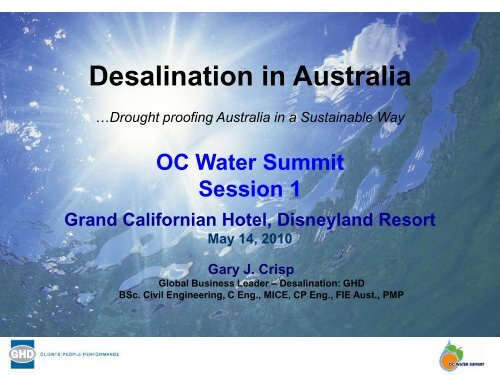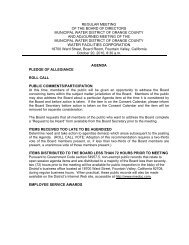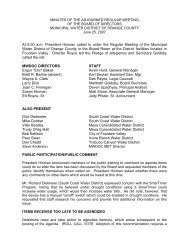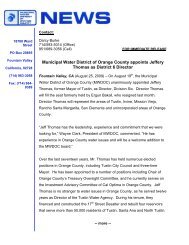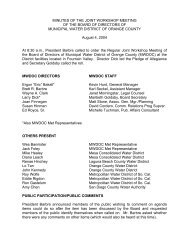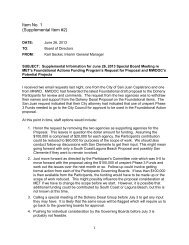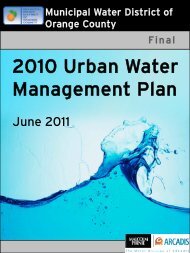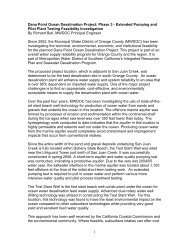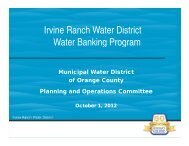Desalination in Australia
Desalination in Australia
Desalination in Australia
Create successful ePaper yourself
Turn your PDF publications into a flip-book with our unique Google optimized e-Paper software.
<strong>Desal<strong>in</strong>ation</strong> <strong>in</strong> <strong>Australia</strong><br />
…Drought proof<strong>in</strong>g <strong>Australia</strong> <strong>in</strong> a Susta<strong>in</strong>able Way<br />
OC Water Summit<br />
Session 1<br />
Grand Californian Hotel, Disneyland Resort<br />
May 14, 2010<br />
Gary J. Crisp<br />
Global Bus<strong>in</strong>ess Leader – <strong>Desal<strong>in</strong>ation</strong>: GHD<br />
BSc. Civil Eng<strong>in</strong>eer<strong>in</strong>g, C Eng., MICE, CP Eng., FIE Aust., PMP
It’s not about water.<br />
It’s aboutenergy!
“Energy is eternal delight!”<br />
Energy is liberation.<br />
William Blake, author, poet, visionary, 1757 – 1827
Presentation Overview<br />
• Introduction<br />
• The Big Six, Includ<strong>in</strong>g Gold Coast
Total Annual* Inflow to Perth Dams** (GL)<br />
1911<br />
1913<br />
1915<br />
1917<br />
1919<br />
1921<br />
1923<br />
1925<br />
1927<br />
1929<br />
1931<br />
1933<br />
1935<br />
1937<br />
1939<br />
1941<br />
1943<br />
1945<br />
1947<br />
1949<br />
1951<br />
1953<br />
1955<br />
1957<br />
1959<br />
1961<br />
1963<br />
1965<br />
1967<br />
1969<br />
1971<br />
1973<br />
1975<br />
1977<br />
1979<br />
1981<br />
1983<br />
1985<br />
1987<br />
1989<br />
1991<br />
1993<br />
1995<br />
1997<br />
1999<br />
2001<br />
2003<br />
2005<br />
Impact of Dry<strong>in</strong>g Climate<br />
- Reduced Inflow to Dams (as at 1 Nov 06)<br />
1000<br />
900<br />
800<br />
700<br />
Annual Total<br />
1911-1974 av (338 GL)<br />
1975 - 1996 av (177 GL)<br />
1997 -2005 av (114 GL)<br />
Regression 1960 to 2005<br />
600<br />
500<br />
400<br />
300<br />
200<br />
2006<br />
100<br />
0<br />
Notes:<br />
- A year is taken as May to April<br />
- 2005/06 <strong>in</strong>flow to 1st November 2006<br />
Courtesy of the Water Corporation
41000 gallons/y per<br />
capita<br />
by 2012 (for Perth)<br />
Wungong Trial<br />
Gnangara P<strong>in</strong>es<br />
Metro Catchments<br />
Catchment Management<br />
Smarter use of Water<br />
Well<strong>in</strong>gton Dam<br />
Brunswick River<br />
Dam<br />
Perth Seawater<br />
<strong>Desal<strong>in</strong>ation</strong> Plant<br />
Surface Water<br />
Groundwater<br />
SW Yarragadee<br />
G<strong>in</strong>g<strong>in</strong><br />
Yanchep<br />
Egl<strong>in</strong>gton<br />
Water Efficiency<br />
From Irrigation<br />
Water Trad<strong>in</strong>g<br />
Water Recycl<strong>in</strong>g<br />
Groundwater<br />
Kw<strong>in</strong>ana Water<br />
Reclamation Plant<br />
20% reuse by 2012 target<br />
Courtesy of Water Corporation
<strong>Desal<strong>in</strong>ation</strong> History<br />
• Aristotle described distillation - 400 BC<br />
• Distillation: <strong>Desal<strong>in</strong>ation</strong> on early ships - 200AD<br />
• Distillation: MED (Norbert Rillieux, 1806 - 1894)<br />
• Coolgardie Water Distillery (WA) - 1895<br />
• Distillation: <strong>Desal<strong>in</strong>ation</strong> MSF - 1956<br />
• Distillation: <strong>Desal<strong>in</strong>ation</strong> MED - 1960<br />
• Distillation: <strong>Desal<strong>in</strong>ation</strong> MVC, METC – 1960<br />
• Membrane: RO (Drs. Sourirajan & Loeb @ UCLA, 1959)<br />
• Membrane: RO (John Cadotte - FilmTec, 1970)<br />
• Membrane: <strong>Desal<strong>in</strong>ation</strong> RO and NF - 1970<br />
• Membrane: Pre-treatment (MF, UF) - 1990<br />
• Membrane: Wastewater (MBR) - 2000<br />
Dr. Sid Loeb<br />
2005 - 2008
SWRO Power Consumption (July 1, 2001)<br />
•
Water Resource Cost Trends: US $/m 3<br />
Perth Seawater <strong>Desal<strong>in</strong>ation</strong> Plant Water Cost 0.90 $/m 3<br />
Cost ($/m 3 )<br />
THE TRIPLE BOTTOM LINE<br />
The TRUE Value of Water<br />
Obta<strong>in</strong>ed with M<strong>in</strong>imal<br />
Environmental Impact<br />
The<br />
Environmental<br />
“Forgotten”<br />
Year<br />
Global Water Intelligence - October 2006<br />
• Water from the oceans is still perceived as a „technology‟ solution, but desal<strong>in</strong>ation should be<br />
recognised as a „policy‟ solution
The <strong>Desal<strong>in</strong>ation</strong> Process
The Big<br />
<strong>Australia</strong>‟s six big desal<strong>in</strong>ation plants
The Big Six – No. 1<br />
Perth Seawater <strong>Desal<strong>in</strong>ation</strong> Plant (Perth I) - 38 mgd<br />
• Client: Water Corporation<br />
• Capacity: 38 mgd<br />
• Plant Capital Cost: $266 million<br />
• Connect<strong>in</strong>g System (IWSS): $51 million<br />
• Total Capital Cost: $317 million<br />
• Total Operat<strong>in</strong>g Cost: $16 million/year<br />
• Unit Cost: $1,172/AF (AU$1.00/m 3 )<br />
• Commission<strong>in</strong>g Completion: 2007<br />
• GHD Involvement: Production of Basis of Design and Basis of Construction<br />
Documents, 3 rd Party Review of Designs from both<br />
Compet<strong>in</strong>g Consortia, Durability Reviews Dur<strong>in</strong>g Design<br />
and Construction Phase, Integration Network Concept and<br />
Detailed Design <strong>in</strong>clud<strong>in</strong>g the largest Pump<strong>in</strong>g Station <strong>in</strong><br />
the Perth Integrated System, the Nicholson Road Pump<strong>in</strong>g<br />
Station (10 MW). Seaglider Oceanographic Measurements<br />
• Configuration: Open Intake, Diffuser Outfall, Travell<strong>in</strong>g Band Screens, Dual<br />
Media Pressure Filtration, 5 Micron Cartridge Filtration,2 Pass<br />
SWRO System, Lime and CO 2 Re-m<strong>in</strong>eralisation<br />
• Seawater Feed Quality: 35000 – 38000 mg/L TDS<br />
• Product Water Quality: < 200 mg/L<br />
• Specific Energy Consumption (SEC): < 13.63 kWh/kgal (3.6 kWh/m 3 )<br />
• Technology Contractor: Degremont (France/Spa<strong>in</strong>)<br />
• Awards: GWI Membrane <strong>Desal<strong>in</strong>ation</strong> Plant of Year 2006<br />
ERI Awarded GWI Environmental Contribution of the Year 2006
Perth Seawater <strong>Desal<strong>in</strong>ation</strong> Plant<br />
16 acres<br />
• Located <strong>in</strong> Kw<strong>in</strong>ana<br />
• 38 mgd Capacity: 40,552 AF/Y<br />
• 24 MW Power Required<br />
• 140 mg/L Product Water<br />
• Commenced operation <strong>in</strong> Nov. „06<br />
• W<strong>in</strong>d Power is used as offset<br />
Courtesy of Water Corporation
Perth Seawater <strong>Desal<strong>in</strong>ation</strong> Plant<br />
6 acres<br />
16 acres<br />
Courtesy of Water Corporation
Perth Seawater <strong>Desal<strong>in</strong>ation</strong> Plant<br />
Seawater Intake System – Inlet Structure<br />
Courtesy of the Water Corporation
Perth Seawater <strong>Desal<strong>in</strong>ation</strong> Plant<br />
Seawater Intake System – Inlet Structure<br />
Courtesy of the Water Corporation
Perth Seawater <strong>Desal<strong>in</strong>ation</strong> Plant<br />
Seawater Intake System – Pipes and Works<br />
Courtesy of the Water Corporation<br />
Courtesy of the Water Corporation
Perth Seawater <strong>Desal<strong>in</strong>ation</strong> Plant<br />
Onshore Active Screen<strong>in</strong>g – Band Screen<br />
Courtesy of the Water Corporation
Perth Seawater <strong>Desal<strong>in</strong>ation</strong> Plant<br />
Seawater Intake and Outlet Works<br />
Courtesy of the Water Corporation
Perth Seawater <strong>Desal<strong>in</strong>ation</strong> Plant<br />
S<strong>in</strong>gle Stage Dual Media Pressure Filtration and Cartridge Filters
Perth Seawater <strong>Desal<strong>in</strong>ation</strong> Plant<br />
Reverse Osmosis Process Flow – Operat<strong>in</strong>g Pr<strong>in</strong>cipals & Arrangement<br />
First Pass<br />
Second Pass<br />
PRETREATED<br />
WATER<br />
HP<br />
Pump<br />
(Common By-pass)<br />
PRODUCTION<br />
1 st Stage<br />
2 nd Stage<br />
Energy Recovery System<br />
(12 x 16 <strong>in</strong> Parallel)<br />
1 ST PASS FEEDING<br />
(recycl<strong>in</strong>g)<br />
REJECT<br />
MDJV <strong>in</strong> Alliance with Water Corporation
Perth Seawater <strong>Desal<strong>in</strong>ation</strong> Plant<br />
High Pressure Pumps 2.6 MW Each (6 <strong>in</strong> total)<br />
Each Pump Equivalent to<br />
15 Toyota Lexus GX<br />
Wagon 8st 4dr Man 6sp<br />
4x4 4.0i<br />
0.179 MW @ 5200rpm<br />
each.*<br />
*Red Book (<strong>Australia</strong>) specifications<br />
Courtesy of the Water Corporation
Perth Seawater <strong>Desal<strong>in</strong>ation</strong> Plant<br />
Circulation Pumps 134 kW each (12 <strong>in</strong> total)<br />
Each Pump Equivalent<br />
to 1 Toyota RAV 4 5st<br />
4dr Man 4x4 2.0i<br />
0.132 MW @ 5200rpm<br />
each.*<br />
*Red Book (<strong>Australia</strong>) specifications<br />
Courtesy of the Water Corporation
Perth Seawater <strong>Desal<strong>in</strong>ation</strong> Plant<br />
RO Build<strong>in</strong>g Look<strong>in</strong>g South – 2 nd Pass RO<br />
Courtesy of the Water Corporation
Perth Seawater <strong>Desal<strong>in</strong>ation</strong> Plant<br />
Pressure Exchanger Rack 1.2 MW each (12 <strong>in</strong> total)<br />
Each Rack Equivalent<br />
to 8 Ford Escape<br />
Wagon 4dr Auto 4sp<br />
4x4 3.0i<br />
0.152 MW @ 4750rpm<br />
each.*<br />
*Red Book (<strong>Australia</strong>) specifications<br />
Courtesy of Water Corporation
Perth Seawater <strong>Desal<strong>in</strong>ation</strong> Project<br />
PX Process
Perth Seawater <strong>Desal<strong>in</strong>ation</strong> Project<br />
Beyond Tomorrow
Perth Seawater <strong>Desal<strong>in</strong>ation</strong> Plant<br />
Potabilization System and Dr<strong>in</strong>k<strong>in</strong>g Water Storage Tank<br />
Courtesy of Water Corporation
Perth Seawater <strong>Desal<strong>in</strong>ation</strong> Plant<br />
Dr<strong>in</strong>k<strong>in</strong>g Water Transfer Pump Station<br />
Courtesy of Water Corporation
Perth Seawater <strong>Desal<strong>in</strong>ation</strong> Plant<br />
Concentrate Discharge and Residuals System<br />
Courtesy of Water Corporation
Perth Seawater <strong>Desal<strong>in</strong>ation</strong> Plant<br />
Br<strong>in</strong>e Discharge System<br />
55yd limit for<br />
mix<strong>in</strong>g zone<br />
32yd mix<strong>in</strong>g zone –<br />
achieve 42 x dilution<br />
20 diffuser ports<br />
at 4.5yd spac<strong>in</strong>g<br />
Outfall<br />
pipel<strong>in</strong>e
Perth Seawater <strong>Desal<strong>in</strong>ation</strong> Plant<br />
Seawater Concentrate - Sal<strong>in</strong>ity<br />
Initial mix<strong>in</strong>g zone<br />
=110 yards<br />
water surface<br />
farfield<br />
45x<br />
dilution<br />
Courtesy of Water Corporation
Perth Seawater <strong>Desal<strong>in</strong>ation</strong> Plant<br />
Real Time Monitor<strong>in</strong>g<br />
Courtesy of Water Corporation
Perth Seawater <strong>Desal<strong>in</strong>ation</strong> Plant<br />
Rhodam<strong>in</strong>e Dye Test<br />
These tests proved<br />
the Mathematical /<br />
Computer Model<br />
analyses.<br />
Note the mar<strong>in</strong>e<br />
growth on the<br />
diffuser ports.<br />
Courtesy of Water Corporation
Under the Surface<br />
Courtesy of the Water Corporation
Perth Seawater <strong>Desal<strong>in</strong>ation</strong> Plant<br />
Susta<strong>in</strong>able Power - W<strong>in</strong>d Energy<br />
Zero Greenhouse Gas Emissions<br />
Stanwell/Griff<strong>in</strong> Jo<strong>in</strong>t Venture - Emu Downs<br />
w<strong>in</strong>d generation facility – at Badg<strong>in</strong>garra<br />
200 north of Perth<br />
Water Corporation is purchas<strong>in</strong>g 66<br />
percent of the energy output<br />
24 MW (185 GW hrs/annum)<br />
Opened on 12 November 2006<br />
Courtesy of the Water Corporation
Perth Seawater <strong>Desal<strong>in</strong>ation</strong> Plant<br />
Susta<strong>in</strong>able Power - W<strong>in</strong>d Energy<br />
• Capacity = 80 MW<br />
• No. of Turb<strong>in</strong>es = 48<br />
• Hub Height = 74 yd<br />
• Blade Length = 44 yd<br />
• W<strong>in</strong>d Farm Area = 18 mile 2<br />
• W<strong>in</strong>d Farm (66%) = 12 mile 2
Perth Seawater <strong>Desal<strong>in</strong>ation</strong> Plant<br />
Courtesy of the Water Corporation
The Big Six – No. 1<br />
Perth Seawater <strong>Desal<strong>in</strong>ation</strong> Plant – Demonstration Plant
The Big Six – No. 2<br />
Gold Coast <strong>Desal<strong>in</strong>ation</strong> Plant - 35 mgd (133 MLD)<br />
• Client: Water Secure - Queensland<br />
• Capacity: 36 mgd<br />
• Plant Capital Cost: $745 million (tunnels $213 million)<br />
• Connect<strong>in</strong>g System (IWSS): $198 million<br />
• Total Capital Cost: $943 million<br />
• Total Operat<strong>in</strong>g Cost: $32 million/year<br />
• Unit Cost: $2,932/AF ($2.03/m 3 )<br />
• Commission<strong>in</strong>g Completion: 2009<br />
• GHD Involvement: Owners Eng<strong>in</strong>eer Construction and Design Review,<br />
Durability, 3 rd Party Review, overall alliance project<br />
management from owners viewpo<strong>in</strong>t, water quality (raw and<br />
product), <strong>in</strong>strumentation and commission<strong>in</strong>g, M&E<br />
Review, SCADA Review<br />
• Configuration: Open Intake, Diffuser Outfall, Drum Screens, Dual Media<br />
Gravity<br />
Filtration, 5 Micron Cartridge Filtration, 2 Pass SWRO<br />
System, Lime<br />
and CO 2 Re-m<strong>in</strong>eralisation<br />
• Seawater Feed Quality: 35000 – 38000 mg/L TDS<br />
• Product Water Quality: < 200 mg/L<br />
• Specific Energy Consumption (SEC): < 12.38 kWh/kgal (3.30 kWh/m 3 )<br />
• Technology Contractor: Veolia (France)<br />
• Awards: GWI Membrane <strong>Desal<strong>in</strong>ation</strong> Plant of Year 2008
Gold Coast <strong>Desal<strong>in</strong>ation</strong> Plant<br />
• Located <strong>in</strong> Tug<strong>in</strong><br />
• 36 mgd Capacity: 38,427 AF/Y<br />
• 22 MW Power Required<br />
• 140 mg/L Product Water<br />
• Commenced operation <strong>in</strong> Nov. „08<br />
• Green Energy as offset
16 mile 43 <strong>in</strong>ch distribution ma<strong>in</strong><br />
8 mg reservoir & pump station<br />
Tw<strong>in</strong> 3.4 m OD <strong>in</strong>take/outfall tunnels<br />
1.5 mile & 1.3 mile sized for 45 mgd<br />
33 mgd Plant ave. 94% availability<br />
36 mgd peak daily production
Chlor<strong>in</strong>e<br />
Chlor<strong>in</strong>e<br />
SCREENS<br />
Chlor<strong>in</strong>e<br />
H2SO4<br />
Fe2(SO4)3<br />
Poly<br />
DUAL MEDIA<br />
FILTERS<br />
FILTERED<br />
SEAWATER<br />
TANK<br />
H2SO4<br />
Antiscalant<br />
SMBS<br />
HP PUMPS<br />
PRETEATMENT<br />
CARTRIDGE<br />
FILTERS<br />
SMBS<br />
THICKENER<br />
Fe2(SO4)3<br />
Poly<br />
INTAKE TUNNEL<br />
INTAKE<br />
OUTFALL<br />
33% Bypass L<strong>in</strong>e<br />
RESIDUALS<br />
REVERSE OSMOSIS<br />
Poly<br />
CENTRIFUGE<br />
ERD<br />
2 nd PASS RO<br />
NaOH<br />
Antiscalant<br />
OUTFALL TUNNEL<br />
1 st PASS<br />
PERMEATE TANK<br />
1 st PASS RO<br />
SEAWATER<br />
FILTERED SEAWATER<br />
BRINE<br />
LOW SALINITY WATER<br />
CO2<br />
Lime<br />
REMINERALISATION<br />
TANK<br />
REMINERALISATION<br />
Chlor<strong>in</strong>e<br />
Chlor<strong>in</strong>e<br />
POTABLE WATER<br />
TANK<br />
DISTRIBUTION<br />
NETWORK
Aerial View of <strong>Desal<strong>in</strong>ation</strong> Plant<br />
Pretreatment<br />
SWRO &<br />
BWRO<br />
Residuals<br />
Treatment<br />
Adm<strong>in</strong><br />
/Lab<br />
Chemical<br />
Storage<br />
Rem<strong>in</strong>eralisation<br />
/Storage<br />
Seawater<br />
Intake<br />
& screen<br />
HV<br />
substation<br />
Br<strong>in</strong>e<br />
discharge<br />
shaft<br />
Potable<br />
water pump<br />
station
Mar<strong>in</strong>e Tunnels<br />
<br />
<br />
SEP supported by tug drawn<br />
barge- <strong>in</strong>stall <strong>in</strong>let/outlet risers<br />
<br />
<br />
<strong>in</strong>let<br />
outlet
Seawater Intake<br />
<br />
<br />
<br />
<br />
<br />
<br />
Intake riser 4.5 yd from seabed 20 yd water depth<br />
Coarse screen 6 <strong>in</strong>ch – vertical bars. Horizontal flow, low velocity to prevent<br />
entra<strong>in</strong>ment
Seawater Intake - Coarse Screen<br />
6.32 m<br />
2.11 m
Pretreatment<br />
Pretreatment<br />
6 Months pilot<strong>in</strong>g of pretreatment<br />
Chemical addition, two static mixers<br />
Four flocculation tanks<br />
18 dual media gravity filters<br />
24 h filter run time
Pretreatment
Residuals<br />
<br />
<br />
Filter backwash (5 mgd), neutralised CIP wastewater, lime sludge treated <strong>in</strong> Residuals<br />
Section<br />
Wastewater is coagulated with ferric sulphate/polymer and clarified <strong>in</strong> lamella separator<br />
Sludge (15% solids) dewatered by centrifuge and sent to isolated cell <strong>in</strong> landfill (max. 65<br />
cubic yard)
<strong>Desal<strong>in</strong>ation</strong> Plant Feed<br />
<br />
<br />
Filtered seawater split <strong>in</strong>to 2 streams<br />
45% to RO % 55% to ERD<br />
RO booster pumps provide suction pressure for HP pumps & ERD booster pumps to feed<br />
ERD<br />
Cartridge filters – 5 µm
First Pass SWRO<br />
Four HP Torishima VSD pumps (5 MW feed) 9 SWRO tra<strong>in</strong>s through<br />
common HP manifold<br />
9 tra<strong>in</strong>s at 100% capacity<br />
Each SWRO tra<strong>in</strong> has Calder DWEER ERD<br />
45% recovery
<strong>Desal<strong>in</strong>ation</strong> Plant Feed – 1 st Pass<br />
4 x High Pressure Pumps 4.8 MW Each<br />
(Each equivalent to 28 Toyota Lexus GX Wagon 8st 4dr Man 6sp 4x4 4.0i<br />
0.179 MW @ 5200rpm each - Red Book Specifications)
Seawater Reverse Osmosis - ERD<br />
Operat<strong>in</strong>g Pr<strong>in</strong>ciples & Arrangement<br />
First Pass<br />
Second Pass<br />
(Common By-pass)<br />
PRODUCTION<br />
PRETREATED<br />
WATER<br />
3 HP Pumps<br />
1 st Stage<br />
2 nd Stage<br />
REJECT<br />
Energy<br />
Recovery<br />
System<br />
(1 per rack)<br />
1 ST PASS FEEDING<br />
(recycl<strong>in</strong>g)
Energy Recovery Device - 1 st Pass<br />
Pressure Exchanger Rack 1.6 MW Each (9 racks <strong>in</strong> total)<br />
(Equivalent to 11 Mazda Tribute Wagon 4dr Auto 4sp 4x4 3.0i<br />
0.152 MW @ 4750rpm each - Red Book Specifications)<br />
Re-circulation Pumps 180 kW Each<br />
Equivalent to 11 Toyota Lexus GX Wagon 8st<br />
4dr Man 6sp 4x4 4.0i 0.179 MW @ 5200rpm<br />
each - Red Book Specifications)
RO Build<strong>in</strong>g Pressure Vessel Racks - 1 st Pass
Rear permeate from SWRO<br />
Second Pass SWRO<br />
3 tra<strong>in</strong>s at 100% capacity<br />
85% recovery<br />
Br<strong>in</strong>e re-circulated back to filtered seawater tank<br />
Total desal<strong>in</strong>ation energy consumption
Rem<strong>in</strong>eralisation and Storage<br />
<br />
<br />
<br />
<br />
<br />
Carbon dioxide and lime water addition<br />
Chlor<strong>in</strong>ation<br />
Two 4 mg glass fused bolted steel tanks (5 h storage) to provide dis<strong>in</strong>fection contact time and<br />
for control<br />
Water quality monitor<strong>in</strong>g TDS< 220 mg/L etc<br />
Ultimately Fluoridation.
Br<strong>in</strong>e Discharge<br />
<br />
<br />
<br />
<br />
Br<strong>in</strong>e (49 mgd) from first pass RO mixed with supernatant from residuals, sent back to<br />
sea<br />
Br<strong>in</strong>e diluted and dispersed through 20 diffusers 60° to the horizon staggered on 306 yd<br />
long diffuser manifold<br />
Extensive model<strong>in</strong>g to ensure optimum mix<strong>in</strong>g to background levels <strong>in</strong> near field<br />
Mix<strong>in</strong>g zone 132 yd x 442 yd
6.5 yd<br />
Diffuser<br />
6.0 yd<br />
1200mm PE
Network Connection<br />
<br />
<br />
<br />
<br />
4 potable water transfer pumps<br />
16 mile of 43 <strong>in</strong>ch pipel<strong>in</strong>e<br />
8 mg reservoir “Rob<strong>in</strong>a Mix<strong>in</strong>g Reservoir” Desal<strong>in</strong>ated water mixed with water from<br />
Mudgeraba WTP<br />
Pump Station Tarrant drive
The Big Six – No. 2<br />
Gold Coast <strong>Desal<strong>in</strong>ation</strong> Plant - 36 mgd (133 MLD)<br />
Courtesy of WaterSecure
The Big Six – No. 2<br />
Gold Coast <strong>Desal<strong>in</strong>ation</strong> Plant - 36 mgd (133 MLD)<br />
Courtesy of WaterSecure
The Big Six – No. 2<br />
Gold Coast <strong>Desal<strong>in</strong>ation</strong> Plant - 35 mgd (133 MLD)<br />
Courtesy of WaterSecure
The Big Six – No. 2<br />
Gold Coast <strong>Desal<strong>in</strong>ation</strong> Plant - 36 mgd (133 MLD)<br />
My Office for 2 years<br />
Courtesy of WaterSecure
The Big Six – No. 2<br />
Gold Coast <strong>Desal<strong>in</strong>ation</strong> Plant - 36 mgd (133 MLD)<br />
Courtesy of WaterSecure
The Big Six – No. 2<br />
Gold Coast <strong>Desal<strong>in</strong>ation</strong> Plant - 36 mgd (133 MLD)<br />
Low HP Pump Feed Pressure < 53 bar<br />
American Translation “769psi”<br />
M<strong>in</strong>imal Drum Screen Screen<strong>in</strong>gs (note the “Wheelie B<strong>in</strong>”)<br />
American Translation “Trash Can”<br />
Courtesy of WaterSecure
The Big Six – No. 2<br />
Gold Coast <strong>Desal<strong>in</strong>ation</strong> Plant - 36 mgd (133 MLD)<br />
3 duty 1 standby High Pressure Pumps (4.8 MW each)<br />
Courtesy of WaterSecure
The Big Six – No. 3<br />
Sydney <strong>Desal<strong>in</strong>ation</strong> Plant - 66 mgd – Expandable to 132<br />
• Client: Sydney Water – New South Wales<br />
• Capacity: 66 mgd (expandable to 132 mgd)<br />
• Plant Capital Cost: $787 million (tunnels $189 million)<br />
• Connect<strong>in</strong>g System: $410 million<br />
• Other: $246 million<br />
• Total Capital Cost: $1,443 million<br />
• Total Operat<strong>in</strong>g Cost: $37 million/year<br />
• Unit Cost: $1,950/AF ($1.74/m 3 )<br />
• Commission<strong>in</strong>g Completion: 2010<br />
• GHD Involvement: Feasibility Study, Preparation of Environmental Statement and<br />
Secured Approvals. Prepared Reference Design and Basis of Design<br />
and Construct, Seawater quality sampl<strong>in</strong>g program, All Geotechnical<br />
Investigations (on & offshore), Pilot Plant Infrastructure Design and<br />
Facilitation, Procurement Method Evaluation, Tender Documentation,<br />
Tender Evaluation (Owners Eng<strong>in</strong>eer), Technical Advisor – Design<br />
Review of Contractors Design, Durability, Construction Surveillance<br />
& Commission<strong>in</strong>g Support, Mar<strong>in</strong>e & Estuar<strong>in</strong>e Monitor<strong>in</strong>g Program<br />
Management, Represented Owner‟s Interest Dur<strong>in</strong>g Construction.<br />
• Configuration: Open Intake, Diffuser Outfall, Drum Screens, Dual Media Gravity<br />
Filtration, 5<br />
• Seawater Feed Quality: 32000 – 41000 mg/L TDS<br />
• Product Water Quality: < 140 mg/L TDS<br />
• Specific Energy Consumption (SEC):< 14.76 kWh/kgal (3.9 kWh/m 3 )<br />
• Technology Contractor: Veolia (France)<br />
• Awards: Not Yet Complete<br />
Micron Cartridge Filtration, 2 Pass SWRO System, Lime and CO 2 Rem<strong>in</strong>eralisation
The Big Six – No. 3<br />
Sydney <strong>Desal<strong>in</strong>ation</strong> Plant - 36 mgd<br />
Courtesy of Sydney Water
The Big Six – No. 3<br />
Sydney <strong>Desal<strong>in</strong>ation</strong> Plant - 66 mgd expandable to 132<br />
Courtesy of Sydney Water
The Big Six – No. 4<br />
Adelaide <strong>Desal<strong>in</strong>ation</strong> Plants I and II – 40 + 40 mgd (150 MLD each)<br />
• Client: South <strong>Australia</strong> Water<br />
• Capacity: 36 mgd + 18 mgd +18 mgd<br />
• Plant Capital Cost: $1,255 million (Estimated)<br />
• Connect<strong>in</strong>g System (IWSS): $246 million (Estimated)<br />
• Total Capital Cost: $1,500 million<br />
• Total Operat<strong>in</strong>g Cost: $67 million/year (36mgd)<br />
• Unit Cost: $3,033/AF ($2.70/m 3 ) Estimated levelised cost<br />
• First Water: December 2012<br />
• GHD Involvement: Owners Eng<strong>in</strong>eer due diligence review dur<strong>in</strong>g<br />
project development phase, Environmental<br />
Impact Statement and Development<br />
Approvals, Water Quality Integration Review<br />
and Ongo<strong>in</strong>g Support.<br />
• Configuration: Open Intake, Diffuser Outfall, capacity to 72<br />
mgd 2 Pass SWRO System, <strong>in</strong>itial capacity 54<br />
mgd Lime and CO 2 Re-m<strong>in</strong>eralisation<br />
• Seawater Feed Quality: 35000 – 38000 mg/L TDS<br />
• Product Water Quality: < 200 mg/L<br />
• Specific Energy Consumption (SEC): < 18.93 kWh/kgal (5 kWh/ m 3 )<br />
• Technology Contractor: Acciona (Spa<strong>in</strong>)<br />
• Awards: Not Completed Yet
The Big Six – No. 4<br />
Adelaide <strong>Desal<strong>in</strong>ation</strong> Plants I and II – 40 + 40 mgd (150 MLD each)<br />
Courtesy of SA Water
The Big Six – No. 5<br />
Southern Seawater <strong>Desal<strong>in</strong>ation</strong> Plant (Perth II) - 40 mgd to 80 mgd<br />
• Client: Water Corporation of Western <strong>Australia</strong><br />
• Capacity: 40 mgd 1 st Stage, 80 mgd 2 nd Stage<br />
• Plant Capital Cost: $640 million (Estimated with double <strong>in</strong>take/outfall)<br />
• Connect<strong>in</strong>g System (IWSS): $98 million (Estimated)<br />
• Total Capital Cost: $738 million (Estimated)<br />
• Total Operat<strong>in</strong>g Cost: $29 million/year (Estimated)<br />
• Unit Cost: $2,042/AF ($1.81/m 3 ) Estimated<br />
• Commission<strong>in</strong>g Completion: 2011<br />
• GHD Involvement: Alliance Team / Plant Eng<strong>in</strong>eer<strong>in</strong>g/ Bid (note, out of 8 expressions of<br />
<strong>in</strong>terest, which were reduced to two by the Water Corporation, the<br />
GHD – Acciona - United Utilities Team was one and did not w<strong>in</strong> the<br />
Alliance Contract. It should be noted that Acciona us<strong>in</strong>g this design<br />
went on to w<strong>in</strong> both Adelaide desal<strong>in</strong>ation plant projects from which<br />
GHD were excluded due to their partial owners role <strong>in</strong> this project and<br />
their Owners Eng<strong>in</strong>eer Role on Melbourne, for whom Acciona was<br />
also bidd<strong>in</strong>g, hence another set of consult<strong>in</strong>g eng<strong>in</strong>eers was<br />
selected by the contractor). Seaglider Oceanographic Measurements<br />
• Configuration: Open Intake, Diffuser Outfall, Travell<strong>in</strong>g Band Screens, UF PVDF<br />
Pressure Filters, 5 Micron Cartridge Filtration, 2 Pass SWRO System,<br />
Lime and CO 2 Re-m<strong>in</strong>eralisation<br />
• Seawater Feed Quality: 35000 – 38000 mg/L TDS<br />
• Product Water Quality: < 200 mg/L<br />
• Specific Energy Consumption (SEC): < 13.63 kWh/kgal (3.6 kWh/ m 3 )<br />
• Technology Contractor: Tecnicas Reunidas, Valoriza Agua (Spa<strong>in</strong>)<br />
• Awards: Not Completed Yet
The Big Six – No. 5<br />
Southern Seawater <strong>Desal<strong>in</strong>ation</strong> Plant (Perth II)<br />
40 mgd Expandable to 80 mgd<br />
Courtesy of Water Corporation
The Big Six – No. 5<br />
Southern Seawater <strong>Desal<strong>in</strong>ation</strong> Plant (Perth II)<br />
150 MLD (40 mgd) Expandable to 300 MLD (80 mgd)<br />
Courtesy of Water Corporation
The Big Six – No. 6<br />
The Victorian <strong>Desal<strong>in</strong>ation</strong> Project - 120 mgd<br />
• Client: Victorian Government<br />
• Capacity: 120 mgd 1 st Stage, 160 mgd 2 nd Stage<br />
• Plant Capital Cost: $1,840 million (Estimated)<br />
• Connect<strong>in</strong>g System (85 km Pipel<strong>in</strong>e): $820 million (Estimated)<br />
• Underground power connection $246 million (Estimated)<br />
• Total Capital Cost: $2,870 million<br />
• Total Operat<strong>in</strong>g Cost: $98 million/year (Estimated)<br />
• Unit Cost: $2,550/AF ($2.27/m 3 ) Estimated<br />
• Commission<strong>in</strong>g Completion: 2011<br />
• GHD Involvement: Feasibility Study, Environment Effects Statement and<br />
Approvals, Reference Design, Seawater quality sampl<strong>in</strong>g<br />
program, all geotechnical <strong>in</strong>vestigations (on & offshore),<br />
Pilot Plant facilities and support, Mar<strong>in</strong>e growth<br />
experiment, Management of Landowner Engagement, GIS &<br />
Mapp<strong>in</strong>g, Data Management, Tender Preparation and<br />
Evaluation, Design Review, Strategic Direction and<br />
Ongo<strong>in</strong>g Support.<br />
• Configuration: 4 m Dia. Undersea Inlet and Outlet Tunnels, Drum Screens,<br />
Dual Media Pressure Filtration, Cartridge Filtration,<br />
2 Pass SWRO System, Lime and CO 2 Re-m<strong>in</strong>eralisation<br />
• Seawater Feed Quality: 35 000 – 38 000 mg/L TDS<br />
• Product Water Quality: < 120 mg/L<br />
• Specific Energy Consumption (SEC): < 17.42 kWh/kgal (4.6 kWh/ m 3 )<br />
• Technology Contractor: Degremont (France/Spa<strong>in</strong>)<br />
• Awards: Not Completed Yet
The Big Six – No. 6<br />
The Victorian <strong>Desal<strong>in</strong>ation</strong> Project - 120 mgd then 160 mgd<br />
Courtesy of Victorian Government
The Big Six – No. 6<br />
The Victorian <strong>Desal<strong>in</strong>ation</strong> Project - 120 mgd then 160 mgd<br />
Courtesy of Victorian Government
Presentation Overview<br />
• Lessons Learnt<br />
• Mar<strong>in</strong>e and Coastal Studies<br />
• Intakes and Outfalls<br />
• The Susta<strong>in</strong>ability of SWRO<br />
• Conclusions
Lessons Learnt: World Wide
Badly Installed Leopold Under Dra<strong>in</strong>s: 3 Year Old<br />
Plant <strong>in</strong> Middle East
General Corrosion: 3 Year Old Plant <strong>in</strong> Middle East
General Corrosion: 3 Year Old Plant <strong>in</strong> Middle East
General Corrosion: 3 Year Old Plant <strong>in</strong> Middle East
General Corrosion: 3 Year Old Plant <strong>in</strong> Middle East
Sloppy Work and General Corrosion: 3 Year Old<br />
Plant <strong>in</strong> Middle East
General Corrosion: 3 Year Old Plant <strong>in</strong> Middle East
Glass Re<strong>in</strong>forced Plastic: 1 Year Old Plant <strong>in</strong> North<br />
Africa
Mar<strong>in</strong>e and Coastal Studies: Perth II<br />
• Water Levels<br />
• Wave Climate<br />
• Sediment Transport and Beach Erosion<br />
• Intake Structure<br />
• Pipel<strong>in</strong>e Protection<br />
• Pipel<strong>in</strong>e Profile<br />
• Outfall Structure
Water Level CD (m)<br />
Mar<strong>in</strong>e and Coastal Studies: Perth II<br />
Water Levels<br />
• Static Water Level<br />
• Tide<br />
• Sea Level Rise<br />
• Surge<br />
2.5<br />
2<br />
Tide<br />
Surge<br />
Total Water Level<br />
Long-term<br />
Operation<br />
Sample Storm Induced Water Level Variation<br />
1.5<br />
1<br />
0.5<br />
0<br />
10/12/2007<br />
00:00:00<br />
10/12/2007<br />
12:00:00<br />
11/12/2007<br />
00:00:00<br />
11/12/2007<br />
12:00:00<br />
12/12/2007<br />
00:00:00<br />
12/12/2007<br />
12:00:00<br />
13/12/2007<br />
00:00:00<br />
13/12/2007<br />
12:00:00<br />
Time
Mar<strong>in</strong>e and Coastal Studies: Perth II<br />
Water Levels<br />
• Tidal Levels<br />
• Datum<br />
• Chart Datum<br />
• <strong>Australia</strong>n Height<br />
Datum
Mar<strong>in</strong>e and Coastal Studies: Perth II<br />
Water Levels<br />
• Extreme High Water Level<br />
Structural Design<br />
Operational Limits<br />
Condition<br />
Stage<br />
Tide Component<br />
(mCD)<br />
Storm Surge (m)<br />
Sea Level Rise<br />
(m)<br />
Total Estimated<br />
WL (mCD)<br />
Maximum Still<br />
Water Level<br />
Now 0.9 1.2 0 2.1<br />
In 100 Years 0.9 1.2 0.45 2.55<br />
M<strong>in</strong>imum Still<br />
Water Level<br />
Now 0.1 0 0 0.1<br />
In 100 Years 0.1 0 0.45 0.55
Height (m)<br />
0<br />
100<br />
200<br />
300<br />
400<br />
500<br />
600<br />
700<br />
800<br />
900<br />
1000<br />
1100<br />
1200<br />
1300<br />
1400<br />
Probablity<br />
Mar<strong>in</strong>e and Coastal Studies: Perth II<br />
Water Levels<br />
• Dynamic Water Level<br />
Load<strong>in</strong>g and<br />
Structural Stability<br />
Surface Elevation Probablity of Occurence<br />
100%<br />
Offshore<br />
@ -10m Depth<br />
@ -8.5m Depth<br />
90%<br />
80%<br />
70%<br />
60%<br />
50%<br />
40%<br />
30%<br />
20%<br />
5.5<br />
3.5<br />
1.5<br />
-0.5<br />
Surface Profile<br />
-5 -4 -3 -2 -1 0 1 2 3 4 5<br />
Surface Level (mCD)<br />
10%<br />
0%<br />
-2.5<br />
-4.5<br />
-6.5<br />
-8.5<br />
Water<br />
Phase<br />
Surface<br />
Angle (degrees)<br />
MSL Bed Level
Mar<strong>in</strong>e and Coastal Studies: Perth II<br />
Wave Parameters<br />
• Offshore<br />
• Based on available<br />
<strong>in</strong>formation from<br />
Rottnest Island<br />
• Near shore<br />
• Based on DHI MIKE SW<br />
Model<br />
• (Under Study)
Wave Height (m) / Wave Preiod (s)<br />
Mar<strong>in</strong>e and Coastal Studies: Perth II<br />
Sediment Transport<br />
12.00<br />
10.00<br />
Significant Wave Height<br />
Peak Wave Period<br />
8.00<br />
• Storm Induced Profile Evaluation<br />
6.00<br />
• Sample Design Storm<br />
4.00<br />
2.00<br />
0.00<br />
• Indicative Beach Profile<br />
Mon 12:00<br />
AM<br />
Mon 12:00<br />
PM<br />
Tue 12:00<br />
AM<br />
Tue 12:00<br />
PM<br />
Time<br />
Wed 12:00<br />
AM<br />
Wed 12:00<br />
PM<br />
Thu 12:00<br />
AM<br />
Thu 12:00<br />
PM<br />
•<br />
• S-Beach and 1D LitPro Models
Mar<strong>in</strong>e and Coastal Studies: Perth II
Mar<strong>in</strong>e and Coastal Studies: Perth II<br />
Intake Structure<br />
• Intakes to be located at -8.0mCD to -8.5mCD<br />
• One Intake for each Phase<br />
• Different options <strong>in</strong>clud<strong>in</strong>g:<br />
• alliance developed options<br />
• Submerged Intake Option<br />
• Seabed Infiltration Option (HDD)<br />
• proprietary <strong>in</strong>take structures such as passive Johnson Screens
GHD Alternative Intake Designs: Perth II<br />
Submerged Intake Option
Seawater Intake Structure – Conventional<br />
Submerged Intake – Perth II
Mar<strong>in</strong>e and Coastal Studies: Perth II<br />
Intake Structure<br />
• Adequate submergence<br />
• Structural stability<br />
• Acceptable <strong>in</strong>take<br />
velocity<br />
• Limited <strong>in</strong>take of<br />
suspended sediments<br />
• Constructability
Mar<strong>in</strong>e and Coastal Studies: Perth II<br />
Seawater Intake - Pipel<strong>in</strong>e
Mar<strong>in</strong>e and Coastal Studies: Perth II<br />
Pipel<strong>in</strong>e Trench
Mar<strong>in</strong>e and Coastal Studies: Perth II -<br />
Conventional Intake Pump<strong>in</strong>g Station
Conventional Seawater Pump Station –<br />
Compartmentalised to Ensure Flood<strong>in</strong>g<br />
Redundancy – Perth II
Conventional Seawater Pump Station – Compartmentalised<br />
to Ensure Flood<strong>in</strong>g Redundancy – Perth II
Conventional Intake - Seawater Screen<strong>in</strong>g – Perth II
Conventional Intake - Seawater Screen<strong>in</strong>g and UF<br />
Pre-treatment – Perth II
GHD Alternative Intake Designs: Perth II<br />
Seabed Infiltration Option (HDD)
Mar<strong>in</strong>e and Coastal Studies: Perth II –Alternative<br />
HDD Seabed Infiltration Intake
Mar<strong>in</strong>e and Coastal Studies: Perth II –Alternative<br />
HDD Pump Station
Mar<strong>in</strong>e and Coastal Studies: Perth II –Alternative<br />
HDD Pump Station
Mar<strong>in</strong>e and Coastal Studies: Perth II –Alternative<br />
HDD Pump Station
Mar<strong>in</strong>e and Coastal Studies: Perth II –Alternative<br />
HDD Pump Station
Mar<strong>in</strong>e and Coastal Studies: Perth II –Alternative<br />
HDD Pump Station
Seawater Pump Station – Perth II
GHD Waste Streams: Perth II
Waste Streams - Perth II<br />
Bypass po<strong>in</strong>ts<br />
Lime discharge<br />
Overflow<br />
UF Overflow<br />
Br<strong>in</strong>e and waste<br />
Discharge<br />
Roof Dra<strong>in</strong>age
Br<strong>in</strong>e & Filter Backwash Tank – Perth II
Br<strong>in</strong>e & Filter Backwash Tank – Perth II
Br<strong>in</strong>e Discharge Tower – Perth II
Br<strong>in</strong>e Discharge Tower – Perth II
Br<strong>in</strong>e Discharge Tower – Perth II
Br<strong>in</strong>e Outfall and Diffuser System – Perth II
Br<strong>in</strong>e Outfall and Diffuser System – Perth II
Intakes and Outfalls<br />
GHD Designs – 32 mgd SWRO Plant – M<strong>in</strong><strong>in</strong>g Company
32 mgd SWRO Plant: M<strong>in</strong><strong>in</strong>g Company – Screened Intake
EXTRACTION OF SURFACE WATER<br />
PASSIVE INTAKE SCREENS
PASSIVE INTAKE SCREEN
PASSIVE SCREEN - HYDROBURST SYSTEM<br />
AIR BACKWASH SYSTEM<br />
4 key components :<br />
4<br />
2<br />
A compressor<br />
A pressurized air receiver<br />
1<br />
One or several discharge valve(s)<br />
A control cubicle<br />
3
PASSIVE SCREEN - HYDROBURST SYSTEM<br />
• Air backwash siz<strong>in</strong>g depends on:<br />
• Intake size<br />
• Maximum backwash frequency<br />
• Distance between air receiver and <strong>in</strong>take<br />
• Key elements : receiver and air compressor<br />
• How it works<br />
• the compressor<br />
produces the compressed air that is then<br />
stored <strong>in</strong><br />
• the receiver<br />
Pressure vessel code construction.. Then<br />
• the valve<br />
opens and lets the air to one of the <strong>in</strong>takes<br />
• The PLC/Clock cubicle<br />
controls the backwash cycles<br />
transmits all the <strong>in</strong>fo to the SOE monitor<br />
allows local manual operation
PASSVE SCREEN - SITE ADAPTATION<br />
• Hydraulic: depend<strong>in</strong>g on the water flow one of the follow<strong>in</strong>g design<br />
can<br />
be selected<br />
SK 1:<br />
Deflector faces the water<br />
flow, forc<strong>in</strong>g debris away<br />
from the screen<br />
Elbow shields the screen<br />
from debris<br />
Stream
PASSVE SCREEN - SITE ADAPTATION<br />
SK 2:<br />
rails<br />
Stream<br />
Wharf <strong>in</strong>stallation with rails for clean<strong>in</strong>g
PASSVE SCREEN - SITE ADAPTATION<br />
SK 3 :<br />
Trough<br />
Stream<br />
Restriction trough to speed up flow<br />
and keep suspended solids from<br />
settl<strong>in</strong>g at the <strong>in</strong>take‟s location
PASSVE SCREEN - SITE ADAPTATION<br />
• Shallow waters:<br />
Make sure that there will always be at least 1/2 D of water above (tide,<br />
summer…) and below the <strong>in</strong>take.<br />
D/2 diameter (D)<br />
D/2
PASSVE SCREEN - SITE ADAPTATION<br />
• Entry canals, pits<br />
In these <strong>in</strong>stances where water speed is very small attention will be paid to<br />
the local conditions to avoid debris/silt accumulation .<br />
For <strong>in</strong>stance <strong>in</strong> a pit it may be worth <strong>in</strong>clud<strong>in</strong>g :<br />
• a sloped bottom<br />
• a pump hole to<br />
pump the dirt<br />
out of the pit<br />
• a pedestal to<br />
keep the <strong>in</strong>take<br />
away from the<br />
bottom
PASSIVE SCREEN - MOUNTING<br />
• Examples of support<br />
Overhang<strong>in</strong>g<br />
from the flange<br />
On a cradle<br />
Concrete foundation
PASSIVE SCREEN - CONFIGURATION<br />
• Several <strong>in</strong>takes<br />
Always try to keep thee flow balanced, i.e. same<br />
length of pip<strong>in</strong>g etc....<br />
Stream<br />
A No No !!
Cu-Ni Intake Screens
Sta<strong>in</strong>less Steel Passive Intake Screens
The Susta<strong>in</strong>ability of SWRO
The Susta<strong>in</strong>ability of SWRO<br />
Mammoth Water Condenser, Coolgardie Water Distillery, 132,000 gpd<br />
The ultimate <strong>in</strong> un-susta<strong>in</strong>ability<br />
In 1896 the worlds largest desal<strong>in</strong>ation plant was built <strong>in</strong> Western <strong>Australia</strong> at Coolgardie
It’s not about water.<br />
It’s aboutenergy!
The Susta<strong>in</strong>ability of SWRO<br />
Affordable <strong>Desal<strong>in</strong>ation</strong> Collaboration (ADC)<br />
Theoretical m<strong>in</strong>imum SEC for seawater @ 35000 mg/L TDS is 2.83 kWh/kgal (0.748 kWhr/m 3 )<br />
To convey 1 kgal of untreated water horizontally over 260 miles uses 12.38 kWh/kgal (3.3 kWh/m3)<br />
Gold Coast <strong>Desal<strong>in</strong>ation</strong> Plant produces high quality water locally at 12.38 kWh/kgal (3.3 kWh/m3)
The Susta<strong>in</strong>ability of SWRO<br />
Specific Energy Consumption for Different Water Sources<br />
Process Electrical Thermal Total<br />
(kWh/m 3 ) (kWh/m 3 ) (kWh/m 3 )<br />
MSF 3.2 – 3.7 9.8 – 6.8 13.0 – 10.5<br />
MED 2.5 - 2.9 6.6 - 4.5 9.0 – 7.4<br />
METC 2.0 - 2.5 12.0 - 6.5 14.0 - 9.0<br />
MVC 8.0 - 17.0 N/A N/A<br />
SWRO 3.3 - 8.5 N/A 3.3 - 8.5<br />
BWRO 1.0 - 2.5 N/A 1.0 - 2.5<br />
Waste Water Reuse 1.0 - 2.5 N/A 1.0 - 2.5<br />
Conventional 0.2 – 1.0 N/A 0.2 – 1.0<br />
Water piped > 250 Miles 3.3 N/A 3.3
The Susta<strong>in</strong>ability of SWRO<br />
Mar<strong>in</strong>e Energy Technologies<br />
• Mar<strong>in</strong>e Energy typically<br />
refers to:<br />
• Wave Power<br />
• Tidal Power<br />
• Ocean Thermal<br />
• Offshore W<strong>in</strong>d
The Susta<strong>in</strong>ability of SWRO<br />
Some Wave Concepts<br />
Ed<strong>in</strong>burgh Duck<br />
Archimedes Wave Sw<strong>in</strong>g<br />
Back Bent Ducted Buoy<br />
AquaBuOY<br />
PS Frog<br />
Grampus OWEL<br />
Bristol Cyl<strong>in</strong>der
The Susta<strong>in</strong>ability of SWRO<br />
Some Wave Concepts – cont‟d<br />
OPT PowerBuoy<br />
SeaVolt<br />
Sea Clam<br />
Fred Olsen FO 3<br />
Manchester Bobber<br />
Wave Dragon<br />
Ocean Wave Master<br />
WaveBob
The Susta<strong>in</strong>ability of SWRO<br />
Some Wave Concepts – cont‟d<br />
CETO<br />
Pelamis<br />
C-Wave<br />
Cockerell Raft<br />
Sperboy<br />
Frond
The Susta<strong>in</strong>ability of SWRO<br />
Some Wave Concepts – cont‟d<br />
CETO
The Susta<strong>in</strong>ability of SWRO<br />
Energy Recovery Devices<br />
CALDER – DWEER<br />
PRESSURE EXCHANGER<br />
KSB – SALTEC<br />
PRESSURE EXCHANGER<br />
AXIAL PISTON PRESSURE<br />
EXCHANGER PUMP<br />
PEI – TURBO BOOSTER<br />
CALDER - PELTON WHEEL<br />
IMPULSE TURBINE<br />
ERI - PX<br />
PRESSURE EXCHANGER
The Susta<strong>in</strong>ability of SWRO<br />
Energy Recovery Devices<br />
IDE – IRIS<br />
PRESSURE EXCHANGER<br />
DYPREX<br />
PRESSURE EXCHANGER<br />
ROVEX PRESSURE<br />
EXCHANGER<br />
FEDCO HYDRAULIC<br />
PRESSURE BOOSTER<br />
ERI – TITAN PX<br />
PRESSURE EXCHANGER
The Susta<strong>in</strong>ability of SWRO<br />
Energy Recovery Devices<br />
AQUALING – ORIGINAL RECUPERATOR<br />
PRESSURE EXCHANGER<br />
AQUALING – NEW RECUPERATOR<br />
PRESSURE EXCHANGER
The Susta<strong>in</strong>ability of SWRO<br />
Water Source Comparison (<strong>in</strong>clud<strong>in</strong>g another unsusta<strong>in</strong>able concept)<br />
14<br />
12<br />
Unit cost ($/m 3 )<br />
12.0<br />
10<br />
Power (kWh/m 3 )<br />
8<br />
6<br />
4<br />
The Susta<strong>in</strong>ability of SWRO<br />
Energy Comparison<br />
Old Fridge Energy Requirement<br />
= 1300 kWh/Year<br />
Efficient <strong>Desal<strong>in</strong>ation</strong> Plant (SEC)<br />
Specific Energy Consumption<br />
= 15.52 kWhr/kgal (4.1 kWh/m 3 )Total<br />
Equivalent Annual Water Production<br />
= 84000 gallons /year (317 m 3 /year)<br />
Garage Fridge<br />
= A s<strong>in</strong>gle total domestic water use<br />
per year <strong>in</strong>side and outside<br />
Reverse Cycle Air 8 kW @ 4 h/day <strong>in</strong><br />
W<strong>in</strong>ter and Summer (6 months)<br />
= 5760 kW/h (Water for 4.5 homes)
The Susta<strong>in</strong>ability of SWRO<br />
Energy Comparison – The MacMansion<br />
Temperature under black roof 61°C.<br />
Radiated Heat 39 °C <strong>in</strong>side house.<br />
Temperature under reflective roof 31°C.<br />
Radiated heat 26 °C <strong>in</strong>side house
The Susta<strong>in</strong>ability of SWRO<br />
Energy Comparison – The MacMansion<br />
If you look at all the energy requirements of new homes (City Beach 8858<br />
kW/hr per year average per home) you would not believe there is a<br />
greenhouse gas emission issue.<br />
Some Big Mac’s (supersized) have up to 15 kW air condition<strong>in</strong>g systems.<br />
To add <strong>in</strong>sult to <strong>in</strong>jury, the latest fashion is a black roof with no eaves –<br />
additional air condition<strong>in</strong>g required (high calories – just like the Big Mac<br />
supersized).<br />
Reverse Cycle Air 15 kW @ 4 hr/day <strong>in</strong> W<strong>in</strong>ter and Summer (6 months) =<br />
10800 kW/h (SWRO water for 8.5 homes<br />
I did not see one black roof on the Canary Islands (and I do not th<strong>in</strong>k it<br />
was just because the islanders have aesthetic appreciation).
The Susta<strong>in</strong>ability of SWRO<br />
Energy Comparison – The MacMansion<br />
The West <strong>Australia</strong>n Tuesday March 8 2007<br />
Record heat ru<strong>in</strong>s fruit,<br />
dra<strong>in</strong>s power<br />
Western Power claimed it coped with the<br />
<strong>in</strong>creased demand despite us<strong>in</strong>g temporary<br />
generators as power consumption hit a peak<br />
of 3574MW at 4.55 pm, beat<strong>in</strong>g Tuesday’s<br />
high of 3533 MW.<br />
The Perth Seawater <strong>Desal<strong>in</strong>ation</strong> Plant uses<br />
0.67% of this energy, whilst Perth was<br />
us<strong>in</strong>g over 30% of the energy for aircondition<strong>in</strong>g.<br />
Note the new umbilical cords to ensure that the<br />
black roof keeps the Big Mac cool <strong>in</strong>side
So …<br />
How Many Jumbos
The Susta<strong>in</strong>ability of SWRO<br />
Energy Comparisons<br />
=<br />
+<br />
+<br />
+<br />
+<br />
+
The Susta<strong>in</strong>ability of SWRO<br />
Energy Comparisons<br />
or, how many PSDP‟s<br />
=<br />
+<br />
+
The Susta<strong>in</strong>ability of SWRO<br />
Energy Comparisons<br />
and the answer is!<br />
=<br />
One Jumbo Jet<br />
Tak<strong>in</strong>g Off Power<br />
Cruis<strong>in</strong>g Power<br />
Full Power of One Eng<strong>in</strong>e<br />
Full Power Requirement PSDP<br />
= 77 MW<br />
= 65 MW<br />
= 26 MW<br />
= 24 MW<br />
Water for 405,000 homes (Aus) 300,000 homes (USA) or a total<br />
116,000 passengers transported <strong>in</strong> one year assum<strong>in</strong>g Jumbo is<br />
always full, and Jumbo‟s cannot use renewable energy.<br />
+<br />
+
So …<br />
How Many Queen Mary II‟s
The Susta<strong>in</strong>ability of SWRO<br />
Energy Comparisons<br />
=<br />
+<br />
+<br />
+<br />
+<br />
+
The Susta<strong>in</strong>ability of SWRO<br />
Energy Comparisons<br />
=<br />
or, how many PSDP‟s<br />
+<br />
+<br />
+
The Susta<strong>in</strong>ability of SWRO<br />
Energy Comparisons<br />
=<br />
and the answer is!<br />
+<br />
Guest Capacity:<br />
• 2,592 lower berths<br />
• 3,056 maximum capacity (Incl. third and fourth berths)<br />
Crew:<br />
•1,253<br />
Power:<br />
•118 MW, gas turb<strong>in</strong>e/diesel electric plant<br />
+<br />
+
Annual Streamflow (GL)<br />
Not So Susta<strong>in</strong>able<br />
Surface Water Source – Serpent<strong>in</strong>e Dam<br />
Serpent<strong>in</strong>e Dam - Streamflow<br />
200.0<br />
180.0<br />
160.0<br />
140.0<br />
120.0<br />
100.0<br />
80.0<br />
60.0<br />
40.0<br />
20.0<br />
0.0<br />
1911<br />
1914<br />
1917<br />
1920<br />
1923<br />
Note: years are water years May to April<br />
Catchment Area 664 km2<br />
1926<br />
1929<br />
1932<br />
1935<br />
1938<br />
1941<br />
1944<br />
1947<br />
1950<br />
1953<br />
1956<br />
1959<br />
1962<br />
1965<br />
1968<br />
1971<br />
1974<br />
1977<br />
1980<br />
1983<br />
1986<br />
1989<br />
1992<br />
1995<br />
1998<br />
2001<br />
2004<br />
Streamflow Longterm average(62 GL) mov<strong>in</strong>g average<br />
1975 to 1994 MAF (37 GL) 1997 to 2004 MAF(24 GL) 2001 to 2005 MAF(19 GL)<br />
Courtesy of the Water Corporation
Seawater <strong>Desal<strong>in</strong>ation</strong> vs. Surface Water Source<br />
Footpr<strong>in</strong>t Comparison – Serpent<strong>in</strong>e Dam<br />
• Constructed from 1957 to 1961<br />
• Catchment area = 256 miles 2 (vs. 12 miles 2 )<br />
• Surface area at FSL = 2,636 acres (vs. 22 acres)<br />
• No <strong>in</strong>-stream flow allocations<br />
• Yield estimated <strong>in</strong> early 50s @ 40,552 acre-feet/year - 98% reliability<br />
• PSDP yield: 40,552 acre-feet/year + @ 100% reliability - 0% failure<br />
• Yield <strong>in</strong> 2006 was 4,055 acre-feet/year ; a 90% reduction<br />
• <strong>Desal<strong>in</strong>ation</strong> 0% failure = 40,552 acre-feet/year - 100% reliability
Future Developments
Future <strong>Desal<strong>in</strong>ation</strong> Developments<br />
SWRO will still become more efficient due to:<br />
• New high rejection membranes<br />
• Chlor<strong>in</strong>e Tolerant Membranes<br />
• New large diameter membranes<br />
• New energy recovery devices<br />
• Membrane pre-treatment advances<br />
• New materials (more plastics and composites)<br />
• Advanced pre-treatment and post treatment
Future <strong>Desal<strong>in</strong>ation</strong> Developments<br />
• Ceramic Membranes<br />
• Non-chemical treatments for dis<strong>in</strong>fection pre- and post treatment<br />
• Chang<strong>in</strong>g of WHO Boron Guidel<strong>in</strong>es to 2.4 mg/L from 0.5 mg/L<br />
(hence only one pass required with a potential sav<strong>in</strong>gs of 15%)<br />
• Optimal Control Systems and Configurations<br />
• Nano-technology and smart membranes<br />
• Forward Osmosis<br />
• High efficiency reverse osmosis (HERO) and Electro Dialysis<br />
Reversal (EDR) may become the solution for <strong>in</strong>land towns where<br />
groundwater sources are limited
Future Developments<br />
Reverse-Reverse Osmosis <br />
(Entropy Recovery - Forward Osmosis - Osmotic Power)<br />
Patents 1971, 1972, 1974, 1975<br />
Papers by Dr. Sid Loeb 1976 through 2000
PSDP L<strong>in</strong>ked to Wastewater Treatment Plant<br />
Gross Available Power<br />
216 ML/day (57 mgd) Seawater Concentrate<br />
216 ML/day (57 mgd) of UF Treated Secondary Wastewater<br />
5MW<br />
At the same time you would mix the wastewater with the concentrate limit<strong>in</strong>g stratification<br />
when return<strong>in</strong>g 34,500 mg/L mixed water to the ocean.
Osmotic Power<br />
Power From Seawater: First Prototype Out, More to Come<br />
FRESH WATER RUSHES TOWARD SALT WATER.<br />
PRESSURE BUILDS. POWER IS PRODUCED. NORWAY‟S FIRST PLANT OPENS BUT<br />
OTHERS ARE LOOKING AT IT AS WELL.<br />
Statkraft is the world’s leader <strong>in</strong> the development of osmotic power. Osmotic power is<br />
clean, renewable energy, with a global potential of 1 600 to 1 700 TWh – equal to Ch<strong>in</strong>a’s<br />
total electricity consumption <strong>in</strong> 2002.<br />
ON TUESDAY, 24 NOVEMBER 2009, HER ROYAL HIGHNESS CROWN PRINCESS METTE-MARIT<br />
OF NORWAY WILL BE OPENING THE WORLD’S FIRST OSMOTIC POWER PLANT AT TOFTE,<br />
OUTSIDE OSLO.<br />
Statkraft says a pilot facility that uses saltwater and freshwater to<br />
generate power could mark a next new source of renewable energy. The<br />
world‟s first osmotic power plant opened today at Tofte, outside of Oslo.<br />
And it <strong>in</strong>cluded a royal kickoff from the Crown Pr<strong>in</strong>cess Mette-Marit of<br />
Norway, who pushed the button that set the turb<strong>in</strong>es <strong>in</strong> motion.<br />
Osmotic power plant opens, with commercial scale ambitions
Osmotic Energy Recovery Patent Pend<strong>in</strong>g<br />
• Gauge Pressure of<br />
60 bar ~ 6 kwh/kgal<br />
Seawater<br />
desal<strong>in</strong>ation with<br />
gauge pressure<br />
recovery at<br />
9.3 kwh/kgal.<br />
• Osmotic Pressure of<br />
60 bar ~ 2.4 kwh/kgal<br />
Seawater desal<strong>in</strong>ation<br />
with gauge pressure<br />
recovery and with<br />
osmotic pressure<br />
recovery at 6.9<br />
kwh/kgal.<br />
Seawater<br />
Intake<br />
Br<strong>in</strong>e<br />
Discharge<br />
Courtesy of Boris Liberman, Ph.D.<br />
Vice-President – IDE Technologies Ltd.<br />
Patent Pend<strong>in</strong>g
Osmotic Energy Recovery Patent Pend<strong>in</strong>g<br />
Osmotic Pressure: 0.3 bar<br />
MBR Process<br />
Seawater<br />
Intake<br />
Br<strong>in</strong>e<br />
Discharge<br />
Gauge Pressure of 60 bar<br />
Osmotic Pressure of 60 bar<br />
Aquifer<br />
Recharge<br />
Well<br />
Groundwater<br />
Pump<strong>in</strong>g<br />
Well<br />
Courtesy of Boris Liberman, Ph.D.<br />
Vice-President – IDE Technologies Ltd.<br />
Patent Pend<strong>in</strong>g
Osmotic Energy Recovery Patent Pend<strong>in</strong>g<br />
MBR Process<br />
SWRO Process<br />
Seawater<br />
Intake<br />
Br<strong>in</strong>e<br />
Discharge<br />
Aquifer<br />
Recharge<br />
Well<br />
Groundwater<br />
Pump<strong>in</strong>g<br />
Well<br />
Courtesy of Boris Liberman, Ph.D.<br />
Vice-President – IDE Technologies Ltd.<br />
Patent Pend<strong>in</strong>g
Osmotic Energy Recovery Patent Pend<strong>in</strong>g<br />
SWRO br<strong>in</strong>e<br />
1m3/s<br />
Pg 60bar, Po 60bar<br />
MBR Treated Water<br />
1m3/s, Pg = 33bar<br />
POp = 0.3 bar<br />
POp 45 bar<br />
POp 0.45 bar<br />
NDF 17 bar<br />
PGp 59.5 bar<br />
PGp 32 bar<br />
SWRO br<strong>in</strong>e<br />
1.9m3/s<br />
Pg-59bar, Po-30bar<br />
MBR Water<br />
0.1m3/s<br />
Courtesy of Boris Liberman, Ph.D.<br />
Vice-President – IDE Technologies Ltd.<br />
Patent Pend<strong>in</strong>g
Why SWRO is Susta<strong>in</strong>able & the Future Solution<br />
1. SWRO reflects the “true benchmark value of water”, the “triple bottom l<strong>in</strong>e” as<br />
environmental, social and f<strong>in</strong>ancial costs are all <strong>in</strong>cluded <strong>in</strong> the unit cost of water.<br />
No conventional source adequately caters for environmental costs.<br />
2. SWRO is drought free and provides a totally new (orig<strong>in</strong>al) source, contrary to<br />
recycl<strong>in</strong>g.<br />
3. SWRO does not disturb rivers, estuaries, delta’s, the sea and associated habitat<br />
(fish, siltation, stagnation and <strong>in</strong>-stream flows). Dams result <strong>in</strong> the sea gett<strong>in</strong>g saltier<br />
<strong>in</strong> conf<strong>in</strong>ed gulfs e.g. Arabian Gulf. Even semi – conf<strong>in</strong>ed Cockburn Sound <strong>in</strong> Perth<br />
has not shown any signs of sal<strong>in</strong>ity <strong>in</strong>crease after 3 years of operation (DB09-278<br />
Perth, <strong>Australia</strong>: Two-year Feed Back on Operation and Environmental<br />
Impact).<br />
4. SWRO does not disturb aquifers and associated habitat (water table, seawater<br />
<strong>in</strong>trusion, spr<strong>in</strong>gs, acid sulphate soils and stygofauna).<br />
5. SWRO br<strong>in</strong>e discharges and residuals can be environmentally managed (this has<br />
been proven beyond any doubt <strong>in</strong> Perth (DB09-278).<br />
6. SWRO is efficient and becom<strong>in</strong>g more efficient with constant advances.
Why SWRO is Susta<strong>in</strong>able & the Future Solution<br />
7. SWRO submerged <strong>in</strong>takes adequately designed, entra<strong>in</strong> negligible algae, zooplankton<br />
and no fish. Entra<strong>in</strong>ment of sea life is m<strong>in</strong>imal with well designed submerged open<br />
<strong>in</strong>takes with low velocity. Only some algae and zooplankton (and no fish) <strong>in</strong> m<strong>in</strong>uscule<br />
quantities are entra<strong>in</strong>ed. Proven by Perth and Gold Coast <strong>Desal<strong>in</strong>ation</strong> Plants.<br />
8. SWRO can use w<strong>in</strong>d or any renewable energy to ensure no emissions.<br />
9. SWRO has the smallest environmental and terrestrial footpr<strong>in</strong>t of any source (Perth 16<br />
acres Land + 6 acres Sea + w<strong>in</strong>d farm 12 miles 2 for 17% of the city’s water).<br />
10. SWRO can be located near to where it is needed.<br />
11. SWRO need not utilise long pipel<strong>in</strong>es/canals (no need for millions of tons of steel,<br />
cement or massive excavations – such as required when “br<strong>in</strong>g<strong>in</strong>g water down from the<br />
north” and us<strong>in</strong>g 4.5 times less energy).<br />
12. SWRO results <strong>in</strong> m<strong>in</strong>imal greenhouse gas production dur<strong>in</strong>g the manufacture of<br />
components.<br />
13. SWRO results <strong>in</strong> m<strong>in</strong>imal greenhouse gas production dur<strong>in</strong>g the construction of the<br />
plant.
Why SWRO is Susta<strong>in</strong>able & the Future Solution<br />
14. The deployment of SWRO plants on coasts ensures that there is a water catchment<br />
plan <strong>in</strong> place (for water quality purposes), ensur<strong>in</strong>g the highest degree of ocean<br />
protection.<br />
15. SWRO results <strong>in</strong> zero evaporation, siltation or salt build-up <strong>in</strong> dams (e.g. Well<strong>in</strong>gton<br />
Dam, WA).<br />
16. SWRO water quality is not affected by bush fires, first ra<strong>in</strong> or activities <strong>in</strong> catchments<br />
which can affect water quality and future run-off (e.g. Melbourne).<br />
17. SWRO could ultimately be partially powered by osmotic power (a new form of<br />
renewable energy). Locate SWRO Plants adjacent to WWT Plants.<br />
18. SWRO can utilise greenhouse off–sets from renewable energy development from<br />
anywhere <strong>in</strong> the world, after all climate change is a global issue.<br />
19. SWRO can be provided at guaranteed full capacity with<strong>in</strong> two years of<br />
environmental clearances be<strong>in</strong>g obta<strong>in</strong>ed.<br />
20. The future development potential of SWRO is still amaz<strong>in</strong>g (especially membranes,<br />
materials, control systems and logic and energy reduction).
Conclusions<br />
• A clean unlimited energy supply is the key to most world problems, <strong>in</strong>clud<strong>in</strong>g<br />
water supply.<br />
• <strong>Desal<strong>in</strong>ation</strong> can have the smallest footpr<strong>in</strong>t of any source <strong>in</strong> <strong>Australia</strong>/ California.<br />
• A substantial component of <strong>Australia</strong>‟s water supply needs will be met by water<br />
reuse and seawater desal<strong>in</strong>ation <strong>in</strong> the medium to long term (18 SWRO and 10<br />
Reuse exist<strong>in</strong>g, under construction and proposed). California could be the same.<br />
• The Perth Seawater <strong>Desal<strong>in</strong>ation</strong> Plant is the most sophisticated and susta<strong>in</strong>able<br />
SWRO plant <strong>in</strong> the world, utilis<strong>in</strong>g the most up-to-date components, it is be the<br />
world‟s model plant and the only large plant us<strong>in</strong>g w<strong>in</strong>d power.<br />
• PSDP will be eclipsed by a more efficient plant, somewhere <strong>in</strong> the world with<strong>in</strong> 3<br />
years, most likely Perth‟s second plant, the Southern Seawater <strong>Desal<strong>in</strong>ation</strong> Plant,<br />
which has to be 80% w<strong>in</strong>d and the other 20% other renewable plus membrane pretreatment.
Conclusions (Cont<strong>in</strong>ued)<br />
• PSDP will be eclipsed by a more efficient plant, somewhere <strong>in</strong> the<br />
world with<strong>in</strong> 3 years, most likely Perth‟s second plant, the Southern<br />
Seawater <strong>Desal<strong>in</strong>ation</strong> Plant, which has to be 80% w<strong>in</strong>d and the other<br />
20% other renewable plus membrane pre-treatment.<br />
• Water Reuse and desal<strong>in</strong>ation are susta<strong>in</strong>able water sources that will<br />
contribute to solv<strong>in</strong>g <strong>Australia</strong>‟s/ California‟s water resource issues.<br />
• SWRO will still become more efficient with new Low Energy High<br />
Rejection Membranes, Large Diameter Membranes, Membrane Pretreatment,<br />
new materials and logic and control systems.
Conclusions (Cont<strong>in</strong>ued)<br />
• State Governments are urged to undertake strategic forward plann<strong>in</strong>g<br />
<strong>in</strong> select<strong>in</strong>g SWRO desal<strong>in</strong>ation and wastewater treatment plant sites<br />
and associated corridors now. This should be planned for 50 years<br />
ahead.<br />
• Western <strong>Australia</strong> has been lead<strong>in</strong>g the country (and world) <strong>in</strong> the use<br />
of desal<strong>in</strong>ation technologies and the diversification of water sources<br />
SWRO, BWRO, MED, MVC, EDR, HERO, renewables.<br />
• Other desal<strong>in</strong>ation technologies to maximise recovery <strong>in</strong> a move to<br />
Zero Liquid Discharge (ZLD) <strong>in</strong>land <strong>in</strong>clude: ARROW, HEEPM, VSEP
“I have said that I thought if we could ever<br />
competitively get fresh water from<br />
saltwater…that it would be <strong>in</strong> the long range<br />
<strong>in</strong>terests of humanity which would really<br />
dwarf any other scientific accomplishment.”<br />
John F. Kennedy, September 22, 1961<br />
“If we could produce clean unlimited energy<br />
at a viable cost, that would <strong>in</strong>deed be a<br />
great service to humanity and would dwarf<br />
any other scientific accomplishment.”<br />
Gary J. Crisp, 2006
Perth Seawater <strong>Desal<strong>in</strong>ation</strong> Plant<br />
Awarded<br />
GWI World Membrane <strong>Desal<strong>in</strong>ation</strong><br />
Plant of the Year 2007<br />
ERI Awarded GWI<br />
Environmental<br />
Contribution of the<br />
Year 2007<br />
Courtesy of Water Corporation<br />
Courtesy of ERI
Gold Coast <strong>Desal<strong>in</strong>ation</strong> Plant<br />
Awarded<br />
GWI World Membrane <strong>Desal<strong>in</strong>ation</strong><br />
Plant of the Year 2009<br />
Courtesy of WaterSecure
International <strong>Desal<strong>in</strong>ation</strong> Association<br />
Awarded 2011 World Congress - to<br />
Perth<br />
Western<br />
<strong>Australia</strong><br />
See You There!
Can California Do the Same <strong>in</strong><br />
SWRO<br />
“Yes We Can”<br />
“Aqua La Vista - Baby”
Questions<br />
Thank you.<br />
GHD | CLIENTS | PEOPLE | PERFORMANCE<br />
Gary Crisp, Bus<strong>in</strong>ess Leader - <strong>Desal<strong>in</strong>ation</strong><br />
BSc. Civil Eng<strong>in</strong>eer<strong>in</strong>g, CP Eng., FIEAust, PMP<br />
T 61 7 3316 4107 | F 61 7 3316 3333 | gary.crisp@ghd.com.au<br />
201 Charlotte Street Brisbane QLD 4000 <strong>Australia</strong> | http://www.ghd.com.au<br />
GHD serves the global markets of: Infrastructure | M<strong>in</strong><strong>in</strong>g & Industry | Defence | Property & Build<strong>in</strong>gs | Environment


